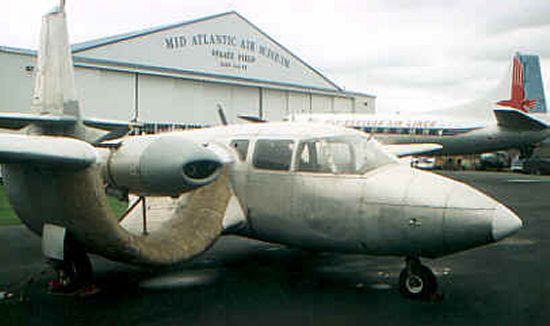|
||||||||||
|
|
||||||||||
|
||||||||||
|
|
||||||||||

The advantage of this arrangement is that the propeller produces a high-speed flow, known as the propeller slipstream, through the channel generating greater lift. Custer, who was actually a relative of the ill-fated Gen. George Custer, hoped to exploit the phenomenon to develop short takeoff and landing (STOL) aircraft.
Willard Custer conceived the channel wing concept after watching a barn roof being torn off by strong winds. He concluded that the high wind velocity over the roof had created such low pressure that it resulted in a lift force greater than the forces holding the roof in place. Custer believed this effect could be duplicated on a wing using the engine to produce the high speed flow. After experimenting with different wing and engine layouts, he found the semi-circular channel arrangement promising as it produced about one-third more lift per square foot of wing area than a traditional wing. It was also hoped that the channel would accelerate the flow through the propeller disc increasing thrust, but the drag created by the channel itself cancelled out any such benefit.
Custer's work on the semi-circular channel design led to the construction of the CCW-1, now on display in the National Air & Space Museum. The first of four prototypes, the CCW-1 first flew in 1942. Custer tested the aircraft both with the outer wing panels shown in the above pictures attached and with them removed removed, leaving only the channels. The machine demonstrated adequate performance, even with one engine inoperative, and could takeoff in as little as 200 ft (61 m). Further prototype development continued over the course of the next two decades, including the CCW-2. The final prototype, the CCW-5, first flew in 1953 and the first production model appeared in 1964.
Despite the promising capabilities of the channel wing, the cheaper Beechcraft Bonanza had captured much of the lightplane market by 1964, and the helicopter had negated the channel wing's STOL performance. Although the aircraft performed well at low speeds, performance suffered at higher velocities because of vibration caused by the high rotation speed of the propeller in such close proximity to the wing. This proximity also resulted in cabin noise issues since the partially ducted propellers generated significant noise as the blades moved in an out of the channel. These factors would probably have caused long-term structural fatigue problems as well. Combined with Custer's refusal to sell his patents to other manufacturers, the channel wing faded into obscurity. In addition to the CCW-1 owned by the National Air & Space Museum, the only other surviving channel wing is the CCW-5 prototype currently undergoing restoration at the Mid Atlantic Air Museum.

In an interesting side note, Custer attempted to sue Fairchild Republic claiming that the placement of the podded
engines on the A-10 Thunderbolt II infringed on his patents,
but he lost the case. Although Willard Custer passed away in 1985, his son Harold has continued work on the
concept and remains optimistic that the channel wing will return.
- answer by Jeff Scott, 15 April 2001
Read More Articles:


|
Aircraft | Design | Ask Us | Shop | Search |

|
|
| About Us | Contact Us | Copyright © 1997- | |||
|
|
|||